Aliger gigas
| Aliger gigas | |
|---|---|
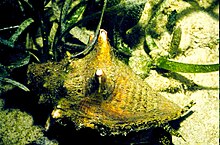
| |
| A live subadult individual of Aliger gigas, turtle grass
| |

| |
| A dorsal view of an adult individual of A. gigas from Chenu, 1844 | |
| Scientific classification | |
| Domain: | Eukaryota |
| Kingdom: | Animalia |
| Phylum: | Mollusca |
| Class: | Gastropoda |
| Subclass: | Caenogastropoda |
| Order: | Littorinimorpha |
| Family: | Strombidae |
| Genus: | Aliger |
| Species: | A. gigas
|
| Binomial name | |
| Aliger gigas | |
| Synonyms[10] | |
|
Strombus gigas Linnaeus, 1758[3] | |
Aliger gigas, originally known as Strombus gigas or more recently as Lobatus gigas,
The queen conch is
.The shell and soft parts of living A. gigas serve as a home to several different kinds of
Its shell is sold as a souvenir and used as a decorative object. Historically, Native Americans and indigenous Caribbean peoples used parts of the shell to create various tools.
International trade in the Caribbean queen conch is regulated under the Convention on International Trade in Endangered Species of Wild Fauna and Flora (CITES) agreement, in which it is listed as Strombus gigas.[12] This species is not endangered in the Caribbean as a whole, but is commercially threatened in numerous areas, largely due to extreme overfishing.
Taxonomy and etymology

History
The queen conch was originally
In the first half of the 20th century, the
Phylogeny
| |||||||||||||||||||||||||||||||||
| A simplified version of the phylogeny and relationships of Strombidae according to Simone (2005)[20]
|
| ||||||||||||||||||||||||||||||||||||||||||||||||||||||||||||
| Phylogeny and relationships of Eastern Pacific and Atlantic Strombus species, according to Latiolais et al. (2006)[21] |
The
With the exception of
In a different approach, Latiolais and colleagues (2006) proposed another cladogram that attempts to show the phylogenetic relationships of 34 species within the family Strombidae. The authors analysed 31 Strombus species, including Aliger gigas (there referred to as Strombus gigas), and three species in the allied genus Lambis. The cladogram was based on
Common names
Common names include "queen conch" and "pink conch" in English, caracol rosa and caracol rosado in Mexico, caracol de pala, cobo, botuto and guarura in Venezuela, caracol reina, lambí in the Dominican Republic and Grenada,[27][28][29][30][31] and carrucho in Puerto Rico.[32]
Anatomy
Shell

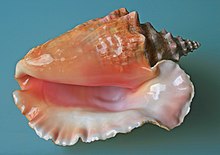


The mature
The spire is a protruding part of the shell that includes all of the whorls except the largest and final whorl (known as the body whorl). It is usually more elongated than in other strombid snails, such as the closely related and larger goliath conch, Lobatus goliath that is endemic to Brazil.[18] In A. gigas, the glossy finish or glaze around the aperture of the adult shell is primarily in pale shades of pink. It may show a cream, peach or yellow colouration, but it can also sometimes be tinged with a deep magenta, shading almost to red. The periostracum, a layer of protein (conchiolin) that is the outermost part of the shell surface, is thin and a pale brown or tan colour.[34][36][37]
The overall shell morphology of A. gigas is not solely determined by the animal's genes; environmental conditions such as location, diet, temperature and depth, and biological interactions such as predation, can greatly affect it.[38][39] Juvenile conches develop heavier shells when exposed to predators. Conches also develop wider and thicker shells with fewer but longer spines in deeper water.[39]
The shells of juvenile queen conches are strikingly different in appearance from those of the adults. Noticeable is the complete absence of a flared outer lip; juvenile shells have a simple sharp
Conch shells are about 95% calcium carbonate and 5% organic matter.[43]
Historic illustrations
Index Testarum Conchyliorum (published in 1742 by the Italian physician and malacologist Niccolò Gualtieri) contains three illustrations of adult shells from different perspectives. The knobbed spire and the flaring outer lip, with its somewhat wing-like contour expanding out from the last whorl, is a striking feature of these images. The shells are shown as if balancing on the edge of the lip and/or the apex; this was presumably done for artistic reasons as these shells cannot balance like this.
One of the most prized shell publications of the 19th century, a series of books titled Illustrations conchyliologiques ou description et figures de toutes les coquilles connues, vivantes et fossiles (published by the French naturalist Jean-Charles Chenu from 1842 to 1853), contains illustrations of both adult and juvenile A. gigas shells and one uncoloured drawing depicting some of the animal's soft parts.[44] Almost forty years later, a colored illustration from the Manual of Conchology (published in 1885 by the American malacologist George Washington Tryon) shows a dorsal view of a small juvenile shell with its typical brown and white patterning.[42]
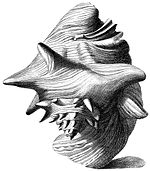 |
 |
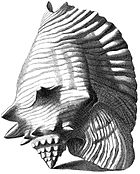 |
 |
Soft parts
Many details about the anatomy of Aliger gigas were not well known until Colin Little's 1965 general study.

Foot/locomotion
The species has a large and powerful foot with brown spots and markings towards the edge, but is white nearer to the visceral hump that stays inside the shell and accommodates internal organs. The base of the anterior end of the foot has a distinct groove, which contains the opening of the pedal gland. Attached to the posterior end of the foot for about one third of its length is the dark brown, corneous, sickle-shaped operculum, which is reinforced by a distinct central rib. The base of the posterior two-thirds of the animal's foot is rounded; only the anterior third touches the ground during locomotion.[20][45] The columella, the central pillar within the shell, serves as the attachment point for the white columellar muscle. Contraction of this strong muscle allows the animal's soft parts to shelter in the shell in response to undesirable stimuli.[45]
Aliger gigas has an unusual means of
Life cycle

Aliger gigas is gonochoristic, which means each individual snail is either distinctly male or distinctly female.[32] Females are usually larger than males in natural populations, with both sexes existing in similar proportion.[52] After internal fertilization,[39] the females lay eggs in gelatinous strings, which can be as long as 75 feet (23 m).[37] These are layered on patches of bare sand or seagrass. The sticky surface of these long egg strings allows them to coil and agglutinate, mixing with the surrounding sand to form compact egg masses, the shape of which is defined by the anterior portion of the outer lip of the female's shell while they are layered.[39][53] Each one of the egg masses may have been fertilized by multiple males.[53] The number of eggs per egg mass varies greatly depending on environmental conditions such as food availability and temperature.[39][53] Commonly, females produce 8–9 egg masses per season,[32][54] each containing 180,000–460,000 eggs,[37] but numbers can be as high as 750,000 eggs.[39] A. gigas females may spawn multiple times during the reproductive season,[37] which lasts from March to October, with activity peaks occurring from July to September.[32]
Queen conch
Ecology

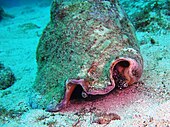

Distribution
Aliger gigas is native to the tropical Western Atlantic coasts of North and Central America in the greater Caribbean tropical zone.
Habitat
Aliger gigas lives at depths from 0.3–18 m[37] to 25–35 m.[35][56] Its depth range is limited by the distribution of seagrass and algae cover. In heavily exploited areas, the queen conch is more abundant in the deepest range.[56] The queen conch lives in seagrass meadows and on sandy substrate,[52] usually in association with turtle grass (species of the genus Thalassia, specifically Thalassia testudinum[40] and also Syringodium sp.)[38] and manatee grass (Cymodocea sp.).[36] Juveniles inhabit shallow, inshore seagrass meadows, while adults favor deeper algal plains and seagrass meadows.[37][62] The critical
Diet
Strombid gastropods were widely accepted as
Interactions
A few different animals establish
Aliger gigas is a
Uses
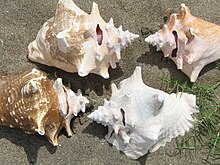
Conch meat has been consumed for centuries and has traditionally been an important part of the diet in many islands in the West Indies and Southern Florida. It is consumed raw, marinated, minced or chopped in a wide variety of dishes, such as salads, chowder, fritters, soups, stew, pâtés and other local recipes.[33][49][36][71] In both English and Spanish-speaking regions, for example in the Dominican Republic, Aliger gigas meat is known as lambí. Although conch meat is used mainly for human consumption, it is also sometimes employed as fishing bait (usually the foot).[59][36] A. gigas is among the most important fishery resources in the Caribbean: its harvest value was US$30 million in 1992,[39] increasing to $60 million in 2003.[72] The total annual harvest of meat of A. gigas ranged from 6,519,711 kg to 7,369,314 kg between 1993 and 1998, later production declined to 3,131,599 kg in 2001.[72] Data about US imports shows a total of 1,832,000 kg in 1998, as compared to 387,000 kg in 2009, a nearly 80% reduction twelve years later.[73]

Queen conch shells were used by
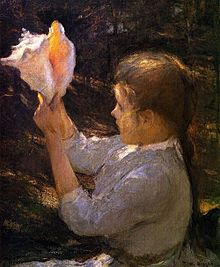
Brought by explorers, queen conch shells quickly became a popular asset in
Very rarely (about 1 in 10,000 conchs),
Research into the conch shell's unique architecture is currently under way at
Status
Threats
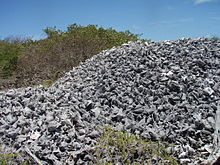
Queen conch populations have been rapidly declining throughout the years and have been mostly depleted in some areas in the Caribbean due to the fact that they are highly sought after for their meat and their value.[84] Within the conch fisheries, one of the threats to sustainability stems from the fact that there is almost as much meat in large juveniles as there is in adults, but only adult conchs can reproduce, and thus sustain a population.[71] In many places where adult conchs have become rare due to overfishing, larger juveniles and subadults are taken before they ever mate.
In the United States (Florida), it is currently illegal to gather or pick the queen conch either recreationally or commercially.[85] In other parts of the world where it is legal, only adult conchs can be fished. The rule is to let each conch have ample time to reproduce before taken out of its habitat, potentially leading to a more stable population. However, this rule has not been followed by countless fishers.[84][71][86] On a number of islands, subadults provide the majority of the harvest.[87] The abundance of Aliger gigas is declining throughout its range as a result of overfishing and poaching. Especially because of overfishing, many pockets of conch communities fall below the critical level needed for reproducing. A 2019 study predicted overfishing could lead to the extinction of queen conchs in as little as ten years.[88] Additionally, if the conch fishery collapses, it could potentially leave over 9,000 Bahamian fishers out of work.[84] Trade from many Caribbean countries, such as the Bahamas, Antigua and Barbuda, Honduras, Haiti and the Dominican Republic, is known or thought to be unsustainable.[86] As of 2001, queen conch populations in at least 15 Caribbean countries and states were overfished or overexploited.[86] Illegal harvest, including fishing in foreign waters and subsequent illegal international trade, is a common problem in the region.[59] The Caribbean "International Queen Conch Initiative" is an international attempt at managing this species.[61] On 13 January 2019, the Bahamas' Department of Marine Resources announced it would be making official recommendations to better protect the conch, including ending exports and increasing regulatory staff.[84]
Presently, ocean acidification is another serious threat to the queen conch. Acidity levels are rising and adversely affecting shellfish larvae. Rising atmospheric CO2 levels result in rising levels of carbonic acid in seawater, which is particularly harmful to organisms with calcium carbonate shells and structures. Certain larval stages of shellfish are very sensitive to lower seawater pH.[89]
In 2022, the US NOAA conducted a review of populations throughout its range; the study places it at a moderate risk of extinction over the next 30 years.[90][91] The study also requested, and received comments from management agencies, nations and associations throughout the Caribbean regarding the status of the species, and implications of listing the species as Threatened under the US Endangered Species Act.
Conservation
The queen conch fishery is usually managed under the regulations of individual nations. In the United States all taking of queen conch is prohibited in Florida and in adjacent Federal waters. No international regional fishery management organization exists for the whole Caribbean area, but in places such as Puerto Rico and the Virgin Islands, queen conch is regulated under the auspices of the Caribbean Fishery Management Council (CFMC).
The species is listed in Appendix II of the
References
- ^ "NatureServe Explorer 2.0". explorer.natureserve.org. Retrieved 19 October 2022.
- ^ "Appendices | CITES". cites.org. Retrieved 14 January 2022.
- ^ a b c Linnaeus, C. (1758). Systema Naturae, 10th ed., vol. 1. 824 pp. Laurentii Salvii: Holmiae (Stockholm, Sweden). p. 745.
- ^ ISBN 978-0-8493-1632-6.
- ^ Clench, W. J. (1937). "Descriptions of new land and marine shells from the Bahama Islands." Proceedings of the New England Zoölogical Club 16: 17–26, pl. 1. (Stated date: 5 February 1937.) On pages 18–21, plate 1 figure 1.
- ^ Smith, M. (1940). World Wide Seashells: illustrations, geographical range and other data covering more than sixteen hundred species and sub-species of molluscs (1 ed.). Lantana, Florida: Tropical Photographic Laboratory. pp. 131, 139.
- ^ McGinty, T. L. (1946). "A new Florida Strombus, S. gigas verrilli". The Nautilus 60: 46–48, plates. 5–6: plate 5, figs. 2–3; plate 6, figs. 7–8.
- ^ Burry, L. A. (1949). "Shell Notes". Vol. 2. pp. 106–109.
- ^ Petuch, E. J. (1994). Atlas of Florida Fossil Shells. Chicago Spectrum Press: Evanston, Illinois., xii + 394 pp., 100 pls. On page 82, plate 20: figure c.
- ^ a b c Rosenberg, G. (2009). "Eustrombus gigas (Linnaeus, 1758)". Malacolog Version 4.1.1: A Database of Western Atlantic Marine Mollusca. Retrieved 27 September 2009.
- ^ a b "Queen Conch".
- .
- .
- ^ a b Clench, W.J.; Abbott, R.T. (1941). "The genus Strombus in the Western Atlantic". Johnsonia. 1 (1): 1–16.
- ^ Brown, R. W. (1954). Composition of Scientific Words (PDF). Baltimore, Maryland, USA: Published by the author. p. 367.
- ^ Robertson, R. (2012). "Buonanni's Chiocciole (1681)". Digital Collections from the Ewell Sale Stewart Library and Archives. The Academy of Natural Sciences of Drexel University, Philadelphia, USA. Archived from the original on 14 January 2013. Retrieved 20 December 2012.
- ^ Buonanni, F. (1684). Recreatio mentis, et oculi in observatione animalium testaceorum Italico sermone primum proposita ... nunc ... Latine oblata centum additis testaceorum iconibus. Romae, Ex typographia Varesii. pp. 531–532.
- ^ a b c d e f g h i Moscatelli, R. (1987). The superfamily Strombacea from Western Atlantic. São Paulo, Brazil: Antonio A. Nanô & Filho Ltda. pp. 53–60.
- ^ Wallin, L. (2001). Catalogue of type specimens 4: Linnaean specimens (PDF). Uppsala, Sweden: Uppsala University Museum of Evolution Zoology section (UUZM). pp. 1–128.
- ^ ISSN 0066-7870.
- ^ PMID 16839783. Archived from the original(PDF) on 20 July 2011. Retrieved 14 April 2010.
- ^ ISSN 0042-3211.
- ISBN 978-1-4200-4558-1.
- S2CID 239142527.
- ^ "Aliger gigas (Linnaeus, 1758)". World Register of Marine Species. Retrieved 3 May 2020.
- ^ Lobatus Swainson, 1837. Retrieved through: World Register of Marine Species on 5 December 2012.
- ^ Rodríguez, B.; Posada, J. (1994). "Revisión histórica de la pesquería del botuto o guarura (Strombus gigas L.) y el alcance de su programa de manejo en el Parque Nacional Archipiélago de Los Roques, Venezuela". In Appeldoorn R.; Rodríguez, B. (eds.). Queen conch biology, fisheries and mariculture. Caracas, Venezuela: Fundación Cientifica Los Roques. pp. 13–24.
- ^ Buitriago, J. (1983). "Cria en cautiverio, del huevo al adulto, del botuto (Strombus gigasL)". Memoria Sociedad de Ciencias Naturales la Salle. 43: 29–39. Archived from the original on 30 December 2013. Retrieved 29 June 2010.
- ^ Avalos, D. C. (1988). "Crecimiento y mortalidad de juveniles de Caracol rosado Strombus gigas en Punta Gavilán, Q. Roo". Documentos de Trabajo. 16: 1–16.
- ^ Eustrombus gigas (Linnaeus, 1758). Retrieved through: World Register of Marine Species on 13 August 2010.
- ^ Posada, J.M.; Ivan, M.R.; Nemeth, M. (1999). "Occurrence, abundance, and length frequency distribution of queen conch, Strombus gigas, (Gastropoda) in shallow waters of the Jaragua National Park, Dominican Republic" (PDF). Caribbean Journal of Science. 35 (1–2): 70–82.
- ^ a b c d e f Davis, M. (2005). "Species Profile: Queen Conch, Strombus gigas" (PDF). SRAC Publication No. 7203. Archived from the original (PDF) on 24 March 2012. Retrieved 17 November 2009.
- ^ a b c d e f g h i j Toller, W.; Lewis, K.A. (2003). Queen Conch Strombus gigas (PDF). U.S.V.I. Animal Fact Sheet. Vol. 19. U.S.V.I. Department of Planning and Natural Resources Division of Fish and Wildlife.
- ^ ISBN 978-0-486-21359-0.
- ^ PMID 20098740.
- ^ a b c d e f g h Leal, J.H. (2002). "Gastropods" (PDF). In Carpenter, K. E. (ed.). The living marine resources of the Western Central Atlantic. Volume 1: Introduction, molluscs, crustaceans, hagfishes, sharks, batoid fishes and chimaeras. FAO Species Identification Guide for Fishery Purposes. FAO. p. 139.
- ^ a b c d e f g h i j k l Puglisi, M. P. (2008). "Strombus gigas". Smithsonian Marine Station at Fort Pierce. Smithsonian Institution. Archived from the original on 30 July 2009. Retrieved 26 October 2009.
- ^ a b c Tewfik, A. (1991)."An assessment of the biological characteristics, abundance, and potential yield of the queen conch (Strombus gigas L.) fishery on the Pedro Bank off Jamaica". Thesis submitted in partial fulfilment of the requirements for the Degree of Masters of Science (Biology). Acadia University, Canada.
- ^ a b c d e f g h i j k McCarthy, K. (2007). "A review of queen conch (Strombus gigas) life-history. Sustainable Fisheries Division NOAA. SEDAR 14-DW-4.
- ^ a b Davis, J.E. (2003). "Population assessment of queen conch, Strombus gigas, in the St. Eustatius Marine Park, Netherlands Antilles" Archived 19 August 2008 at the Wayback Machine. St. Eustatius Marine Park.
- ^ ISBN 978-1-58238-148-0.
- ^ .
- ^ "Conch shell gives nano insights into composite materials". ScienceDaily. Retrieved 15 April 2018.
- ^ "Chenu's Mollusks (1842–1853)". Digital Collections. The Academy of Natural Sciences. Archived from the original on 14 January 2013. Retrieved 23 September 2010.
- ^ a b c d e f Little, C. (1965). "Notes on the anatomy of the queen conch, Strombus gigas". Bulletin of Marine Science. 15 (2): 338–358. abstract.
- S2CID 25580163.
- ^ Coan, E.V.; Kabat, A.R.; Petit, R.E. (2010). 2,400 Years of Malacology (PDF) (7th ed.). American Malacological Society. p. 874. Archived from the original (PDF) on 22 April 2018. Retrieved 13 April 2010.
- doi:10.1002/jez.1400360204. Archived from the originalon 5 January 2013.
- ^ a b c Fish and Wildlife Research Institute (2006). "Queen conch: Florida's spectacular sea snail". Sea Stats. Florida Fish and Wildlife Conservation Commission. Archived from the original on 14 July 2011. Retrieved 31 August 2010.
- ^ Hesse, K. O. (1980). "Gliding and climbing behaviour of the queen conch, Strombus gigas" (PDF). Caribbean Journal of Science. 16: 105–108.
- ^ Berg, C.J. (1975). "Behavior and ecology of conch (superfamily Strombacea) on a deep subtidal algal plain". Bulletin of Marine Science. 25 (3): 307–317.abstract.
- ^ a b c d Ulrich Wieneke (ed.) Lobatus gigas. In: Gastropoda Stromboidea. modified: 22 November 2008. Retrieved 23 June 2009.
- ^ a b c Robertson, R. (1959). "Observations on the spawn and veligers of conchs (Strombus) in the Bahamas". Proceedings of the Malacological Society of London. 33 (4): 164–171.
- ^ Davis, M.; Hesse, C.; Hodgkins, G. (1987). "Commercial hatchery produced queen conch, Strombus gigas, seed for the research and grow-out market". Proceedings of the Gulf and Caribbean Fisheries Institute. 38: 326–335.
- ^ a b Davis, M.; Bolton, C.A.; Stoner, A.W. (1993). "A comparison of larval development, growth, and shell morphology in three Caribbean Strombus species". The Veliger. 36 (3): 236–244.
- ^ a b c Ehrhardt, N.M.; Valle-Esquivel, M. (2008). Conch (Strombus gigas) Stock Assessment Manual (PDF). U.S. Virgin Islands, Commonwealth of Puerto Rico: Caribbean Fishery Management Council. pp. 128 pp.
- ISBN 978-0-87893-097-5.
- ^ ISBN 978-92-5-106031-5.
- ^ a b c d e f NOAA."Queen Conch (Strombus gigas)". Retrieved 4 July 2009.
 This article incorporates text from this source, which is in the public domain.
This article incorporates text from this source, which is in the public domain.
- JSTOR 1939361.
- ^ a b "International Queen Conch Initiative". NOAA: Caribbean Fishery Management Council. Retrieved 27 September 2009.
- .
- ISSN 1616-1599.
- ^ a b Robertson, R. (1961). "The feeding of Strombus and related herbivorous marine gastropods". Notulae Naturae of the Academy of Natural Sciences of Philadelphia (343): 1–9.
- ^ Stoner, A.; Ray, M. (1996). "Queen conch, Strombus gigas, in fished and unfished locations of the Bahamas: effects of a marine fishery reserve on adults, juveniles, and larval production" (PDF). Fishery Bulletin. 94 (3): 551–565.
- ^ S2CID 85612140.
- ^ ISSN 0260-1230.
- ^ a b c Iversen, E.S.; Jory, D.E.; Bannerot, S. P. (1986). "Predation on queen conchs, Strombus gigas, in the Bahamas". Bulletin of Marine Science. 39 (1): 61–75.
- doi:10.1111/j.1095-8649.1986.tb05149.x. Archived from the originalon 21 October 2012.
- ^ a b Robertson, R. (2011). "Cracking a queen conch (Strombus gigas), vanishing uses, and rare abnormalities" (PDF). American Conchologist. 39 (3): 21–24. Archived from the original (PDF) on 23 September 2015.
- ^ a b c Isl, The (23 January 2013). "Virgin Islands Vacation Guide & Community". Retrieved 13 April 2010.
- ^ a b c CITES (2003). Review of Significant Trade in specimens of Appendix-II species. (Resolution Conf. 12.8 and Decision 12.75) Archived 7 July 2009 at the Wayback Machine. Nineteenth meeting of the Animals Committee, Geneva (Switzerland), 18–21.
- ^ NOAA (2009). National Marine Fisheries Service Fisheries Statistics and Economics Division. [1]. Retrieved 4 July 2009.
- ^ Squires, K. (1941). "Pre-Columbian Man in Southern Florida" (PDF). Tequesta (1): 39–46. Archived from the original (PDF) on 24 June 2010. Retrieved 14 April 2010.
- ISBN 0-8223-3924-2.
- ^ a b c Todd, J. (2011). "Conch shells on coins" (PDF). American Conchologist. 39 (1): 12–13. Archived from the original (PDF) on 23 September 2015.
- ^ ISBN 978-0-395-69779-5.
- ^ "Palau issues queen conch pearl coin". Coins Weekly. Retrieved 10 June 2015.
- ^ "Country: North America, Grenada". Stamp Collectors Catalogue. Retrieved 9 June 2015.
- ^ Moscatelli, R. (1992). Seashells on Stamps, Vol. II. Antonio A. Nano & Filho Ltd. p. 439.
- ^ ISSN 0016-626X. Archived from the originalon 29 January 2013.
- ^ "Conch Pearls: Sunken Treasure from the Caribbean". www.purepearls.com. Retrieved 4 August 2018.
- ^ "Conch shells spill the secret to their toughness". MIT News. Retrieved 15 April 2018.
- ^ a b c d "The Bahamas' iconic conch could soon disappear". National Geographic Society. 16 January 2019. Archived from the original on 17 January 2019.
- ^ "International Affairs-Queen Conch". United States Fish and Wildlife Service. Retrieved 13 August 2019.
- ^ a b c Theile, S. (2001). "Queen conch fisheries and their management in the Caribbean" (PDF). Traffic Europe: 1–77.
- ^ Oxenford, H.A.; et al. (2007). Fishing and marketing of queen conch (Strombus gigas) in Barbados (PDF). CERMES Technical Report. Vol. 16. University of the West Indies, Barbados: Centre for Resource Management and Environmental Studies.
- S2CID 59476805.
- ^ "Ocean Acidification's impact on oysters and other shellfish". www.pmel.noaa.gov. Retrieved 15 April 2018.
- doi:10.25923/4ykr-1m56.)
{{cite journal}}: Cite journal requires|journal=(help)CS1 maint: multiple names: authors list (link - )
- ^ "Annexes of the SPAW Protocol". SPAW-RAC's website. National Park of Guadeloupe - SPAW/RAC. Retrieved 19 October 2015.
- ^ "SPAW Protocol Annex III" (PDF). SPAW-RAC's website. National Park of Guadeloupe - SPAW/RAC. Retrieved 19 October 2015.
- ^ Appendices I, II and III. cites.org website. Retrieved 4 July 2009.
- NOAA Fisheries Office of International Affairs website: CITES. Retrieved 4 July 2009.
- ^ "Standing Committee Recommendations". CITES Official Documents No 2003/057. 2003. Archived from the original on 21 October 2010. Retrieved 16 April 2010.
- ^ "Vedas Vigentes en el Territorio Colombiano". Instituto Colombiano Agropecuario (Official Website). Ministerio de Agricultura y Desarrollo Rural, Colombia. Retrieved 19 October 2015.
- ^ "Conchservation - Bahamas National Trust". bnt.bs. Retrieved 15 April 2018.
Further reading
- Coomans H.E. (1965). "Shells and shell objects from an Indian site on Magueyes Island, Puerto Rico". Caribbean Journal of Science 5 (1–2): 15–23. PDF.
- Spade, D.J.; Griffitt, R.J.; Liu, L.; Brown-Peterson, N.J.; Kroll, K.J.; et al. (2010). "Queen Conch (Strombus gigas) Testis Regresses during the Reproductive Season at Nearshore Sites in the Florida Keys". PMID 20856805.
- Stoner, A.W.; Waite, J.M. (1991). "Trophic biology of Strombus gigas in nursery habitats: diets and food sources in seagrass meadows". .
External links
- Institute, Waitt. "Queen Conch Factsheet". Waitt Institute. Archived from the original on 19 September 2015. Retrieved 8 June 2015.
- ARKive – images and movies of the queen conch (Strombus gigas)
- Animal Diversity Web: Strombus gigas
- Microdocs Archived 24 October 2012 at the Wayback Machine: Life cycle of the conch Archived 26 June 2009 at the Wayback Machine
- Bermuda Department of Conservation Services (includes Queen Conch Recovery Plan)
- Photos of Aliger gigas on Sealife Collection

